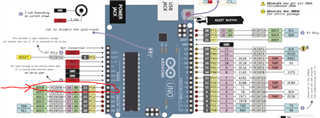I'm trying to use the SDK 15.0 saadc example with a potentiometer on AIN0, and I'm getting weird values. Left pot pin connected to VDD, right pot pin to GND, center pin to P0.03(A0). The output is reading anywhere from 42-45 if I don't touch the potentiometer - regardless of it's rotation. If I turn it toward ground and leave it there, I'll see the values momentarily dip to into the 30s then return to the 42-45 range. If I turn it toward VDD and leave it there, they jump up into the 50s, then return to 42-45. Similarly, if I connect AIN0 directly to VDD or GND, I get a single reading in the 30s or 50s, then it returns to the 42-45 range. I've tried setting up the board in the arduino IDE and the analog examples work fine there. They'll read full range to reflect the potentiometer. Am I misunderstanding what this example does? I saw another question describing something similar, but it is unanswered.



